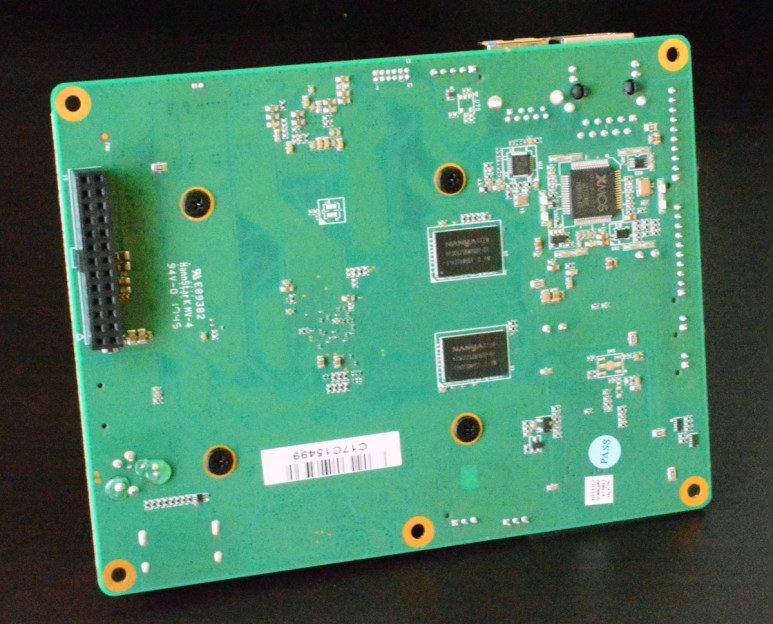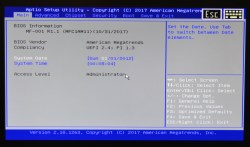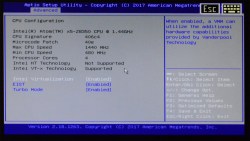How To Install Windows 10 On Atomic Pi
Several months ago, a foreign Kickstarter project from 'Team IoT' appeared that seemed besides good to be true. The Diminutive Pi was billed equally a high-ability alternative to the Raspberry Pi, and the specs are astonishing. For thirty five American buckaroos, you lot get a single board reckoner with an Intel processor. Yous become sixteen Gigs of eMMC Flash, more than enough for a basic Linux organisation and even a cut-down version of Windows 10. You lot have WiFi, you have Bluetooth, you lot take a existent fourth dimension clock, something so many of the other single lath computers forget. The all-time part? It's merely thirty 5 dollars.
Naturally, people lost their minds. In that location are many challengers to the Raspberry Pi, but nothing then far can beat the Pi on both price and performance. Could the Atomic Pi exist the single lath reckoner that finally brings the folks from Cambridge to their knees? Is this the figurer that will revolutionize Stem education, get on a postage stamp, and sell tens of millions of units?
No. The answer is no. While I'yard not allowed to telephone call the Atomic Pi "literal garbage" because our editors insist on the technicality that it's "surplus" because they were purchased before they hit the trash cans, at that place will be no customs built effectually this thirty five dollar single board figurer. This is a piece of electronic flotsam that will become downwards in history right side by side to the Ouya panel. There will be no new Diminutive Pis made, and I highly doubt there will ever be any software updates. Come up throw your coin abroad on silicon, fiberglass and metal detritus! Or maybe you have a utilise for this thing. Run across the Atomic Pi!
x86? In My Single Board Estimator Ecosystem? It's More Likely Than You Think.
At outset glance, the Atomic Pi doesn't look like your usual single board figurer. At that place's no power jack or USB port, something that we've come to wait on all our little electronic baubles. It seems the Atomic Pi is simply a module meant for a larger product. With this many JST connectors, you would just presume this is a module custom-built for a larger product. Probably not something relating to automotive tech, but at the very to the lowest degree some sort of IoT dwelling goods product. Maybe even a robotic juicer.
Speculation is one thing, and proof is another. Here's the FCC documentation for the Diminutive Pi. This thing was originally designed for the Kuri robot, a 'home robot' that was launched at CES in January, 2017. The robot originally cost $700, and was described every bit, 'an Amazon Repeat with wheels and optics'.
Amazon will be releasing their own 'Repeat duct taped to a Roomba' in the side by side year or so, and the Kuri robot was before its time. Mayfield Robotics, the makers of the Kuri, paused operations. But they however had some hardware sitting around, notably some fancy single board computers loaded upward with an x86 chip. These modules went on the auction block and Squad IoT snapped them up and put together a Kickstarter. This is the Atomic Pi. It is industrial surplus repackaged as a novelty device marketed towards people who 'practise things' with single board computers. What kind of things? I have no idea. Emulators? Home automation? A magic mirror?
Only virtually 28,000 Diminutive Pis will ever exist produced. They're already made, and right at present the ones that haven't been shipped are sitting in a warehouse, ready to be flashed with the latest OS. Atomic Pi has misrepresented themselves by saying they 'built' several thousand units already. This is incorrect, the only engineering that has gone into the Atomic Pi is the power adapter and breakout board.
The people behind the Atomic Pi are working on an Atomic Pi 2, or something of that nature, and while in that location are very few details, we practise know this volition cost significantly more than than $35. In the meantime, we accept something that is a surplused bit of an unsuccessful product. Again, less than thirty g Atomic Pis will ever be produced, a fraction of the number of Ouya consoles ever congenital. The Raspberry Pi sold 100,000 on the first day, and I haven't even seen an old Pi with a 26-pivot header and a existent RCA jack in ages.
I could very hands say this is the Silicon Valley platonic of repackaging literal garbage and selling it as a groundbreaking disruption, simply I don't write for Slate or The Atlantic. No, the Atomic Pi is what you lot get when you try to fill an existential void past buying stuff. The Atomic Pi fills a market need for guys who think the ability to install Kali Linux constitutes a personality.

The Review
The Atomic Pi features an Intel Atom x5-Z8350, a quad-core SoC designed for Windows tablets. This is a iii-twelvemonth-erstwhile chip clocked at ane.44 GHz (base, upwards to 1.92 GHz) with ii GB of RAM. There'southward a DirectX 11.2-capable GPU, and overall you're looking at a organisation that would accept been more than acceptable for desktop utilise in 2010, sufficient for Outlook and Discussion in 2015, and something that'll run emulators in 2020. In other words, if you put this into the context of a desktop computer, you'll be getting something that plays Fallout 3. Perchance Fortnite. The GPU (Cherry-red Trail) is supported by Linux, and has support for OpenGL and video decoding. We're non dealing with a crappy Mali GPU here; this 1 really works.
The Diminutive Pi isn't being sold as a tiny brick of a desktop computer with a huge heatsink. This is a single board computer, and any review must place it in the context of being a single board computer. This means it must take some GPIO pins, or some way to blink an LED from the command line. Here, the Atomic Pi is sufficient for express applications: you lot get six GPIOs and two UARTs. In that location are a few boosted GPIOs and other ports sprinkled around the board, including a few USB ports on JST connectors. In terms of support for add-ons, external coprocessors, and other connectivity, the Atomic Pi is sufficient. At that place volition never be an unabridged ecosystem congenital around add-on boards for the Atomic Pi, but that's what happens when you only make a few thousand of something.

In terms of software support, the Atomic Pi ships with Ubuntu 18.04.1 LTS; this is simply what you do when you ship a plain vanilla unmarried board reckoner with Linux — just grab the latest Ubuntu LTS and phone call information technology a day. WiFi and Bluetooth work in Linux, although you will demand antennas, and neither the WiFi or Bluetooth RF section of the lath have metal RF shields installed.
The real question: does the Atomic Pi exercise Windows? Yeah, however Windows 10 istight on 16 GB of eMMC. To do anything useful, you'll need to install from an SD card, and with that comes the problems of running an OS from an SD card we meet in all unmarried board computers.
Finally, the large question. The question anybody wants answered. Does the Diminutive Pi exercise emulation? Information technology doesn't matter: google analytics data tells me that you're probably reading this on a desktop or a laptop, not a mobile device. You therefore have access to a much more than powerful computer that is capable of emulating N64 and Playstation games. Don't bother with emulation on the Atomic Pi. According to the community, emulation is a waste on both the Atomic Pi and the Raspberry Pi.
Atomic Pi: Should You Bother?
No, you shouldn't carp. You just wasted precious moments of your life reading this review. Sad virtually that.
Any review, or any consideration at all of the Atomic Pi, must take into account that it will ultimately be a passing mention in a footnote of the history of single lath computers. At that place is no future when there are no more thirty thousand of these boards to go around. This isn't necessarily a bad thing, as many impressive builds have started off by finding some discarded equipment on the side of the curb, left out for the trash. Simply a unmarried board reckoner is ultimately defined past its ecosystem. With a baked-in production limit, at that place tin can exist no community. Without a community, there is no future.
If you want a toy, sure, pick upward an Diminutive Pi. Here'due south the link. If information technology's out of stock, in that location's probably going to be more. But the selling points the Atomic Pi offers — an x86 machine for cheap, with HDMI, that tin run Windows — is satisfied by amend machines. Accept a look at the AcePC T11. This is an x86 box that uses the same chipset as the Atomic Pi, has double the corporeality of RAM, more eMMC, and support for a SATA drive. It only costs $130, and that gets you a power supply, more than than one USB port, WiFi and Bluetooth antennas, and an enclosure. You lot also get a power supply. Did I mention the AcePC 11 includes a power supply?
Alternatively, if you desire the same Intel flake in a pocketable course cistron, the AcePC T5 plugs right into an HDMI port. Information technology uses the same Cherry Trail CPU as the Diminutive Pi and comes with WiFi and Bluetooth antennas. The AcePC T5 besides comes with a power supply and costs but $100.
The price reference for the single board computer market has been set by the Raspberry Pi, and that means 30 five dollars. Right now, I tin can purchase a Pi iii Model B+ for thirty seven dollars and 70 viii cents, with free i-day delivery from Amazon. Any competitor to the Raspberry Pi must vanquish information technology on either price or performance. The OrangePis and their ilk compete on price. The Atomic Pi certainly beats the Pi on functioning and meets it on price. However, this is a false economic system, every bit the Atomic Pi is one-off industrial surplus. If that's your matter, and y'all need a cheap x86 organisation, go for it. Just at that place are improve options, and you will only save coin by confabulating your own ability supply if you value your time at null.
Source: https://hackaday.com/2019/06/06/the-atomic-pi-is-it-worth-it/
Posted by: wrightbrev1976.blogspot.com




0 Response to "How To Install Windows 10 On Atomic Pi"
Post a Comment